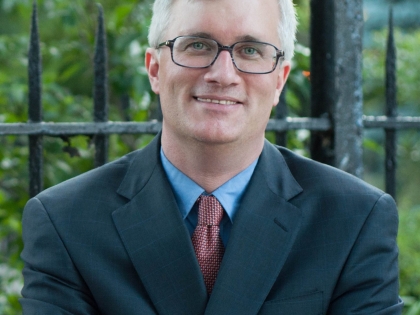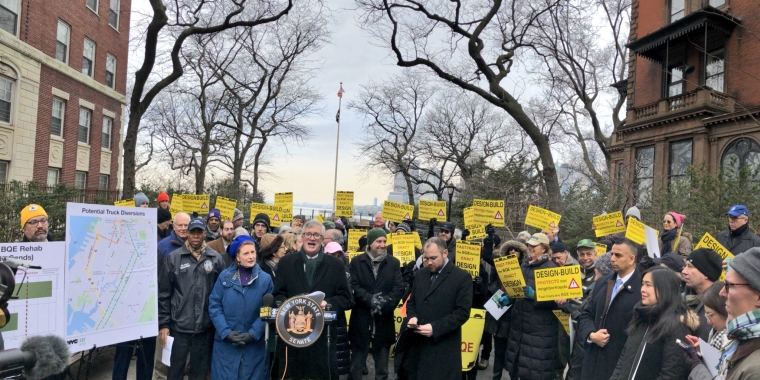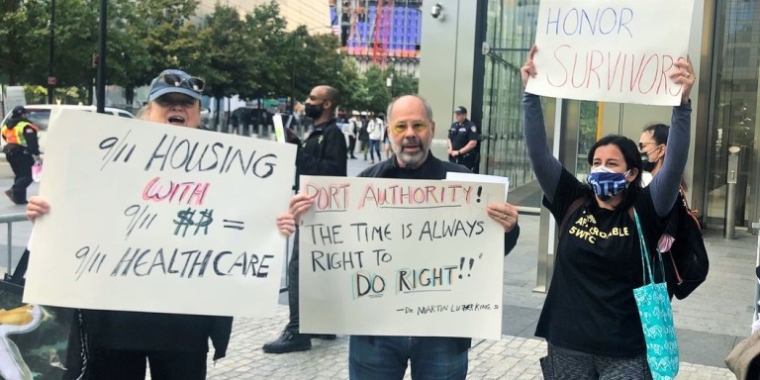
Elected Officials, City Commissioners, Community & Business Leaders Urge Governor Cuomo to Speed Up and Streamline BQE Rehabilitation Project
February 9, 2018

With “design-build” contracting process, BQE project would end two years sooner and taxpayers would save at least $100 million
Without design-build, the DOT will have to redirect trucks onto local Brooklyn streets
The Governor’s Executive Budget Proposal allows five additional state agencies to use design-build, but ignores critical New York City projects like the BQE Rehab
(Brooklyn, NY) -- Today, a group of elected officials including Senator Brian Kavanagh, Assemblymember Jo Anne Simon, City Comptroller Scott Stringer, City Council Speaker Corey Johnson, Brooklyn Borough President Eric Adams, Senator Velmanette Montgomery, Assemblymember Robert Carroll, and Council Members Ydanis Rodriguez and Mark Treyger joined City commissioners and community and business leaders to urge Governor Andrew Cuomo to accelerate and streamline necessary construction on the BQE by authorizing “design-build” contracting.
Without design-build, the project will stretch beyond 2026 and trucks will have to be redirected into Brooklyn neighborhoods -- leading to noise, congestion, and safety concerns, along with disruption for anyone who uses I-278 from Staten Island to Queens.
“The BQE is a critical part of our city’s circulatory system, connecting Staten Islanders, Brooklynites, Queensites, and Manhattanites for 70 years. It’s understandable that after decades of heavy use, the BQE needs repairs -- but we have to make sure that while we’re repairing this artery, we aren’t damaging our neighborhoods in the process,” Senator Brian Kavanagh said. “Forcing trucks off the BQE and onto neighborhood streets isn’t a solution -- it would be a massive failure of government. Design-build can help us avoid this crisis, while saving more than $100 million. That’s why so many Brooklynites are out here today, and it’s why 19 state legislators from both parties are committed to getting this done in the budget.”
“The BQE triple cantilever is on life support. Without the ability to employ design-build procurement for its reconstruction, the welfare of residential and business communities throughout Staten Island, Brooklyn and Queens, is imperiled. Not only would design-build save taxpayers over $113 million and decrease construction time by a crucial two years, but without it, massive trucks would be compelled to travel through Downtown Brooklyn – the City’s third largest commercial district – because the BQE would be unable to support their weight. These mandatory diversions would paralyze traffic throughout the corridor, damaging the region’s economy. With design-build, reconstruction can take place before trucks would need to be banned from the BQE. Governor Cuomo recognizes the benefits of design-build for the state’s transportation projects; there should be no question that this critical Interstate highway needs the same authority. The bottom line is that New Yorkers need design-build authority and we need it now. I strongly urge Governor Cuomo to include authorization for design-build in this year’s budget,” said Assemblymember Jo Anne Simon.
“At a time when the city is facing at least $1.5 billion worth of threats, every dollar counts. Design Build has the power to save New Yorkers hundreds of millions with absolutely no cost to the State. And it’s not just money. Using Design Build, the city can shave years off critical construction projects. It’s time we’re given the same advantages as everybody else,” said Mayor Bill de Blasio.
Comptroller Scott M. Stringer said: "Every day we wait means lost time and lost dollars, and those are things we just can’t afford. We need to see design-build for the BQE. It's the right thing — and the smart thing — to do to get this project done quickly and efficiently."
“The BQE is an integral thoroughfare that millions of New Yorkers depend on every day to travel throughout the five boroughs,” said Public Advocate Letitia James. “Without an expedited process of upgrades, our communities will be overrun with traffic and our ability to travel efficiently greatly compromised. New York City needs design-build now to address this looming crisis.”
"The city is at a critical juncture where there is a real opportunity to expedite repairs of the aging BQE through the Design Build process," said NYC Council Speaker Corey Johnson. "Unfortunately and unnecessarily, this effort keeps hitting a wall. Any further delay of this process will only clog city streets, impact businesses and turn an already congested area into a parking lot. Approving Design Build will streamline the process, saving time and cutting costs. It's a win-win situation for everyone. I thank the NYC Department of Transportation, the NYC Department of Design and Construction and our partners in State government for their tireless efforts to see this come to fruition."
The BQE is a major access point for drivers traveling between Brooklyn and Manhattan on the East River bridges, and serves as a crucial link between Staten Island, Brooklyn, Queens, and Manhattan. The highway has not had a major rehabilitation since it was constructed seven decades ago, in the 1940s. The 1.5 mile stretch between Atlantic Avenue and Sands Street includes a series of 21 concrete and steel bridges over local roads, along with a highly complex “triple cantilever,” which stacks two roadways beneath the Brooklyn Heights Promenade. Currently, this section of the BQE carries 150,000 vehicles per day, including roughly 15,000 heavy vehicles. During the midday rush, up to 300 tractor-trailers travel over the Atlantic-Sands section of the BQE every hour.
The City DOT estimates that, due to corrosion and other wear, it will have to bar trucks from the Atlantic-Sands section of the BQE starting in 2026 to extend the roadway’s lifespan. If trucks were diverted, they would potentially travel along Columbia Street, Atlantic Avenue, Court and Jay Streets, Tillary Street, Flatbush Avenue, and 3rd and 4th Avenue. This would seriously disrupt Brooklynites’ lives, leading to traffic congestion, noise, pollution, and safety hazards. In addition it would create turmoil for anyone driving on the BQE from Staten Island to Queens.
The DOT, however, believes the City can avoid that situation through design-build.
For a graphic of potential truck diversion routes, click here.
Under the traditional “design-bid-build” process, construction would stretch until 2028 -- but if a more-streamlined design-build process is authorized for the BQE repairs before Spring 2018, the DOT should be able to complete construction by 2025. Design-build is also projected to save at least $100 million in taxpayer dollars.
For a graphic comparing the design-build timeline to the traditional procurement timeline, click here.
New York State has used design-build on large infrastructure projects, including the Governor Mario M. Cuomo Bridge and the Kosciuszko Bridge.
Earlier this year, a bipartisan group of 19 state legislators from Brooklyn and Staten Island sent a letter to Governor Cuomo supporting design-build authorization for the BQE. The Governor’s Executive Budget Proposal did not include that authorization -- but did enable five additional state agencies to take advantage of this streamlined process. Governor Cuomo has an opportunity to fix this oversight in his 30-Day Budget Amendments, which are due on February 15th.
"The work on the BQE, from Atlantic to Sands, is urgently needed -- and DOT must get the ball rolling on the work this year," said DOT Commissioner Polly Trottenberg. "We thank forward-thinking legislative leaders who recognize how central an artery the BQE is, and who know that Design Build could save at least $113 million and allow us to shave two years on fixing this single project. I thank Mayor de Blasio for his commitment to this and other major capital projects, and we look forward to our work with our Albany partners to gain the authority we need to get the job done with the least disruption and inconvenience to hundreds of thousands of New York drivers and Brooklyn residents."
“Every state and every major city across the country use Design Build because it’s been proven to save time and save money,” said Acting Commissioner Ana Barrio of the NYC Department of Design and Construction (DDC). “The BQE is the most critical project for which Design Build is essential, but DDC’s portfolio of infrastructure and public building projects could benefit from Design Build as well, including the facilities that would expedite the closing of Rikers Island. New Yorkers should not have to wait for the BQE and other projects to be built under the current system. We ask Albany please to let us improve our construction process and let us spend taxpayer dollars more efficiently.”
Senator Jesse Hamilton said, “Design Build is the right choice for keeping an acceptable timetable and budget, for controlling traffic congestion, and for minimizing inconvenience to neighborhood residents. We must ensure that we provide the tools for this critical BQE rehabilitation to be a success and Design Build is precisely the tool we need for this job.”
"The streamlining of this project with Design Build will literally be a life changing decision for countless Staten Islanders. We all realize the necessity of the triple cantilever. However, some of these commuters already face the longest travel in the Nation. We don't need to force them into residential traffic congestion to lengthen their commute, harm the local streets, and create a problem for an unknown amount of years to come," said Senator Diane Savino.
“Design-Build is a no brainer,” said Assemblyman Michael Benedetto. “It’s quicker and cheaper-what is there to debate about?”
“The reconstruction of the Brooklyn-Queens Expressway (BQE) triple cantilever is an important and necessary endeavor. This will be very costly and take years to complete and that is why authorizing design-build for this project is so important. It will allow the City of New York to expedite this critical rehabilitation process by as many as two years and will save taxpayers over $113 million, based upon a conservative estimate of the project’s current cost of $1.9 billion,” Assemblymember Robert Carroll said. “The State has authorized design-build for projects similar in nature in the past, and it has saved money, time, and curtailed the strain and impact on local communities directly impacted by the construction. The BQE is a main transportation artery and it’s rehabilitation is critical, and as a State, we must ensure this work is completed in the most cost-effective and time sensitive way possible – authorizing design-build is the best way to do that.”
“Design-build will protect local roadways and buildings from costly, sometimes irreversible damage and ensure that the nightmare of daily BQE traffic doesn't drag on for yet another generation," said Assemblyman Steven Cymbrowitz. "I join my colleagues in urging Governor Cuomo to authorize it for the BQE project."
“Design-build is an essential tool for the BQE Rehab. The negative impacts the project will have on the community is immeasurable, from pollution and noise to truck traffic on our local streets. Not only will the quality of life be negatively affected, businesses will also suffer. We must ensure that we lessen the impact of the BQE Rehab as much as possible. I urge Governor Cuomo to utilize this necessary tool—we’ve already seen its success,” said Assemblyman Joseph Lentol.
“The BQE is in crucial need of repair, but NYC cannot afford another costly and drawn out bureaucratic process. The Governor and state lawmakers must consider time and tax dollars and authorize the use of design-build in the state budget to streamline the rehabilitation of the BQE," said Assemblymember Nicole Malliotakis.
“I proudly stand alongside my colleagues in government, as well as community leaders and advocates alike, to urge Governor Cuomo to authorize New York City’s use of design-build for the BQE rehabilitation project. Funding this common sense measure in the state budget could save our state a tremendous amount of money and valuable time by streamlining procurement and construction for infrastructure projects such as the BQE. However, without this authorization in the budget, New York City DOT reports that the BQE repairs may take nearly a decade to complete. Moreover, large trucks will be diverted onto local roads in our community. This would not only be unacceptable to our thousands of families living in our communities, but this would almost certainly cause further congestion issues; something Governor Cuomo has been seeking to address,” said Assemblyman Walter Mosley.
“Time and time again, government projects take too long to complete and cost way more than they should. By using design build with the BQE we have the opportunity to save millions of dollars and see the project finished sometime before the next millennium. Equally important, we can save our neighborhoods from being overrun by truck traffic, which already presents an environmental and safety nightmare scenario,” said Council Member Justin Brannan.
"NYC should have access to design-build," said NYC Council Finance Committee Chairperson Daniel Dromm. "Local implementation of the program would not only help Brooklyn Heights residents avoid unnecessary hardship, it is a fiscally-sound program that eliminates waste. Its use as a project delivery method has proven successful across the state, saving New York tax payers millions of dollars. Because design-build is the epitome of good government, I once again call upon Albany to pass legislation allowing NYC to utilize it."
“The Design Build approach is exactly what the City needs to ensure that New Yorkers are getting the most from the hard earned tax dollars they send to City Hall and Albany. How many times have we heard that a project is late or cost more than the initial estimate? By granting the city the authority to utilize Design Build for the BQE rehabilitation project, the state is showing that it expects the same level of commitment, excellence and efficiency for city projects as it does for state projects. After all, when New York City saves money, New York State does as well,” said Council Member Rafael Espinal.
“New Yorkers deserve safe streets and efficient highways to keep our city moving. The proposed reconstruction of the BQE's cantilever has the potential to enhance traffic flow and reduce congestion. Unfortunately, without a streamlined procurement process, this important project will drag on, forcing truck traffic and congestion into Brooklyn communities. The Design-Build model, currently used on upstate transportation projects, has the possibility of improving efficiency and achieving cost savings for tax payers. I applaud the NYC DOT for their leadership in recognizing the urgency in utilizing the Design-Build Authority model in this project. As the Chair of the Subcommittee on Capital Budget, I am proud to support this effort and stand with my colleagues in calling upon the State to allow our city to move forward in using Design-Build in this critical infrastructure project,” said Council Member Vanessa Gibson.
"If we don't get this right today, tomorrow we'll be pointing fingers -- let's join hands around design-build instead," said Council Member Stephen Levin. "Everyone should be on the side of getting projects done more quickly and efficiently. No one should be in favor of diverting caravans of 40 ton trucks through our neighborhoods. But that's exactly what will happen if we don't act and support design-build. I'm joining with my colleagues in government and, most important of all, the residents of our communities, to ask that everyone come together design-build."
“These repairs are greatly needed and they must not cause further disruption in the lives of hard-working New Yorkers. Design-build is important in efficiently and cost-effectively completing this project. I hope to see design-build applied in many other projects in the interest of improving the way New Yorkers move about the city, whether by car, on bikes, or mass transit,” said Council Member Ydanis Rodriguez, chair of the Council Committee on Transportation.
"Design-build will save our city time and money," said Council Member Mark Treyger. "Expediting the BQE's much-needed repairs while saving our taxpayers $100 million is just common sense. Design-build is also the right approach from a safety perspective: without it, trucks will be rerouted into our neighborhoods, which is a disaster waiting to happen. New Yorkers deserve safe streets and prudent projects that benefit our city every step of the way."
Peter Bray, Executive Director of the Brooklyn Heights Association said: “The passage of Design-Build authorization by the State Legislature will stave off an enormous threat to the wellbeing of every Brooklyn resident. Without its enactment during the current Albany session, 16,000 trucks will need to be daily diverted by 2026 onto our streets due to the ongoing deterioration of the BQE. That will of course cause unimaginable congestion, but it will also create unsafe conditions for anyone who uses these local streets which aren't designed for large trucks. Our communities will be grateful to those in Albany who now choose to elevate our communities' needs above personality and political rivalry to ensure that our neighborhoods do not become collateral damage to these divisions. Our message is simple: Enact Design Build Now!”
"New York is facing an unprecedented infrastructure crisis and we can no longer afford to put projects on the back-burner. For major revitalization efforts such as the BQE, design-build is the only way forward, not only saving time and money, but also critically minimizing the disruption to our communities. With tens of thousands of vehicles using the road every day and millions of taxpayer dollars at stake, this project is too big and too vital to get wrong. We urge the Governor to make the BQE project a priority for New York and authorize design-build,” said Regina Myer, President of the Downtown Brooklyn Partnership.
Kendra Hems, President of the Trucking Association of New York, said: “Infrastructure projects should be completed in the most cost-effective and timely manner possible. Allowing design-build for the Brooklyn Queens Expressway will ensure both. Without it, tens of thousands of trucks will be restricted from using the BQE and diverted through residential neighborhoods. It will also add significant costs to the project. Trucks account for only 7% of vehicle miles traveled in New York State and the industry pays 34% of all tolls and taxes paid by state motorists, so completion of a project like this for the least amount of money is equally important to us."
“Given New York City’s urgent infrastructure needs, we must ensure design-build authorization for the BQE and other major projects immediately. Design-build has become the industry standard for projects similar to the triple-cantilever, and the Mario Cuomo and Kosciuszko bridges are prime examples of the method’s time and cost-saving benefits. New York’s taxpayers and commuters, and the residents of Brooklyn, deserve the same advantages on the BQE project. We cannot delay design-build authority for New York City any longer – the time is now.” said Carlo A. Scissura, Esq., President and CEO, New York Building Congress.
"The nuances of the procurement process don't matter to drivers," said Alec Slatky, Manager of Government Relations for AAA Northeast. "Drivers want road construction done expeditiously, safely, and economically. Design-build can help check all those boxes on the Brooklyn-Queens Expressway project, so New York City should absolutely be able to use it."
“New York must update its procurement tools to include design-build as an option for local agencies that are striving to carry out capital programs on a more timely and efficient basis. We cannot afford further delay,” said Kathryn Wylde, President & CEO, Partnership for New York City.



